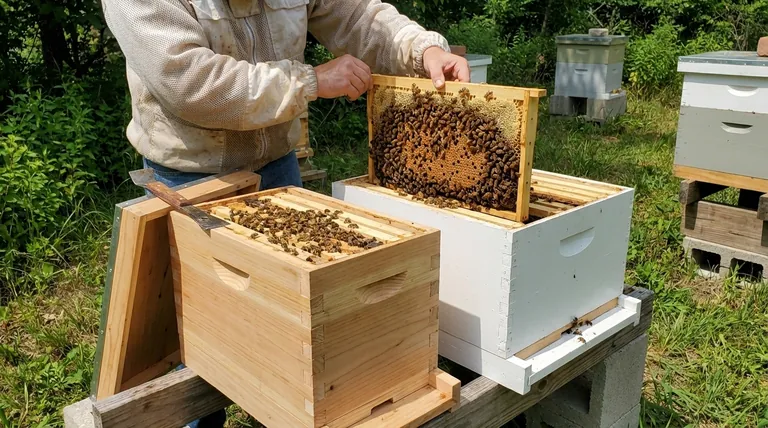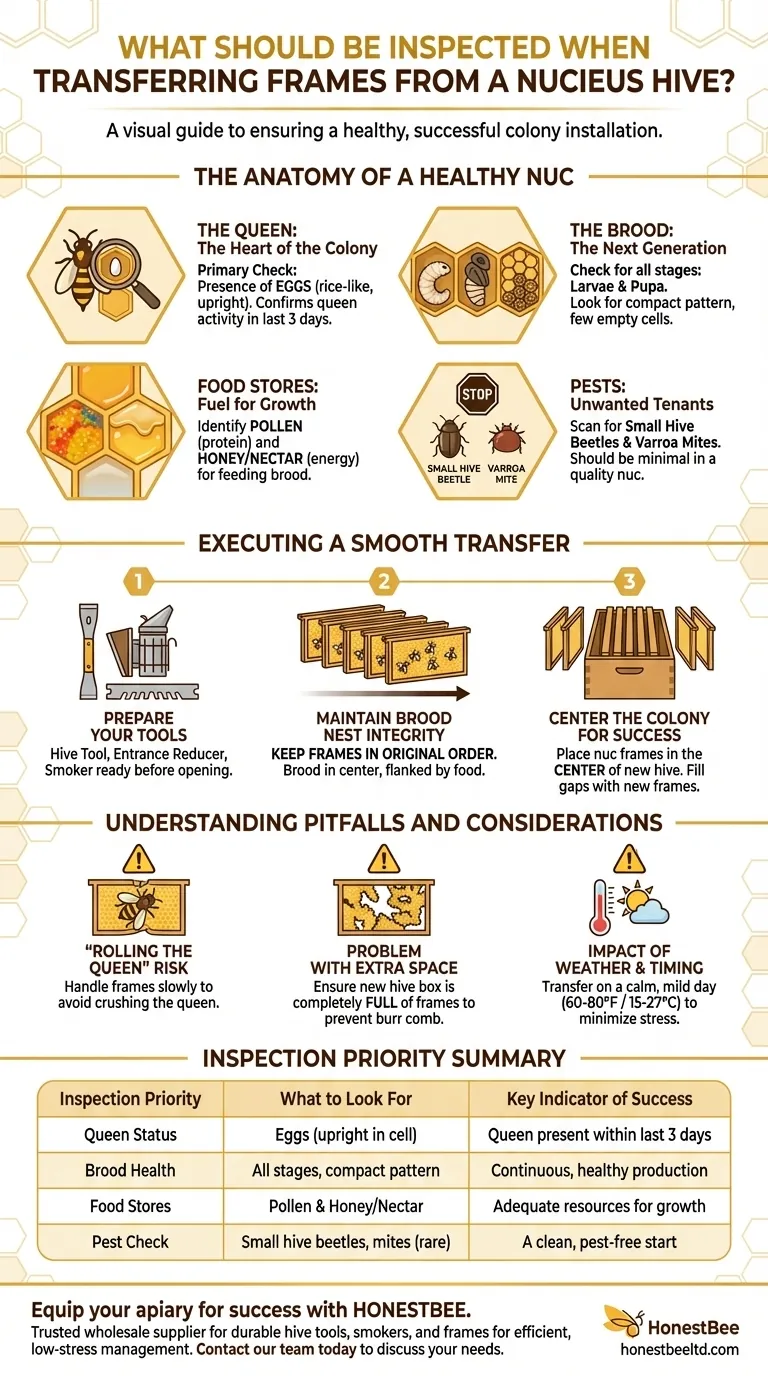When transferring frames from a nucleus hive, your primary inspection should confirm the presence of the queen (or her recent activity), evaluate the health of the brood, check for adequate food stores, and perform a quick scan for pests. This initial assessment is a critical step to ensure you are installing a healthy, viable colony that is positioned for successful growth in its new home.
Your goal during a nuc transfer is not just to move bees; it is to perform a quick but thorough health assessment. A careful inspection confirms you have a "queenright" colony with the resources and population needed to thrive.

The Anatomy of a Healthy Nuc
Think of the nuc transfer as the colony's first physical exam in your care. Each frame tells a story about its health and potential.
The Queen: The Heart of the Colony
Finding the queen herself is ideal but not always necessary. The most critical sign is evidence that she is actively laying.
Look for tiny, rice-like eggs, one per cell, standing upright at the bottom. The presence of eggs confirms a queen was laying within the last three days, which is the gold standard for a "queenright" colony.
The Brood: The Next Generation
A healthy colony has a robust nursery. You should see all stages of developing bees, which indicates a continuous laying cycle.
Inspect for larvae, which are small, white, c-shaped grubs in open cells. Also, look for pupa, which are developing bees sealed under a light brown, papery capping. A healthy brood pattern is compact and consolidated, with few empty cells.
Food Stores: Fuel for Growth
Bees need resources to draw out new comb and feed the young. Identify the two main types of food stores.
Pollen, which looks like a colorful paste (often orange or yellow), is the bees' protein source for raising brood. Honey and nectar provide the carbohydrates for energy. Capped honey will be sealed under white wax cappings, while uncapped nectar will look wet and shiny inside the cells.
Pests: Unwanted Tenants
A reputable nuc provider will have managed pests, but a quick check is always wise.
Look for small hive beetles, which are small, dark beetles that scurry away from light. While less common in a nuc, also be aware of varroa mites, tiny reddish-brown parasites that would be on the bees themselves, though this is unlikely in a quality nuc.
Executing a Smooth Transfer
How you handle the frames is as important as what you see on them. The goal is a calm, orderly transition that minimizes stress on the colony.
Prepare Your Tools
Have your equipment ready before you open the nuc. A hive tool is essential for gently prying the frames loose. An entrance reducer is useful for the new hive to help the small colony defend its new, larger space. A smoker can help calm the bees if they become agitated.
Maintain the Brood Nest Integrity
This is a critical rule: keep the frames in their original order as you transfer them. The bees have strategically organized their brood nest with brood in the center, flanked by pollen and then honey. Preserving this layout reduces the colony's stress.
Center the Colony for Success
Place the five frames from the nuc directly in the center of your new, larger hive body. Then, add new, empty frames to fill the box on either side. This encourages the bees to expand the nest outward in a natural, symmetrical pattern.
Understanding the Pitfalls and Considerations
A successful transfer involves avoiding common mistakes that can set a new colony back.
The "Rolling the Queen" Risk
Handle frames with slow, deliberate movements. When moving or inspecting a frame, be careful not to crush bees between it and the adjacent frame or the hive wall. Accidentally killing the queen is the single biggest risk during a transfer.
The Problem with Extra Space
Your new hive box must be completely full of frames. Leaving a large gap will encourage the bees to build uncontrolled, chaotic burr comb that makes future inspections nearly impossible.
The Impact of Weather and Timing
Plan your transfer for a calm, mild day with minimal wind, ideally between 60-80°F (15-27°C). Performing the transfer in poor weather stresses the bees and makes them more defensive, increasing the risk of problems.
Making the Right Decision for Your Colony
Your inspection will guide your next steps. Trust what the frames tell you.
- If your primary focus is confirmation of health: Look for all three brood stages (eggs, larvae, pupae) and a compact pattern. This is the clearest sign of a healthy, productive queen and a colony ready for growth.
- If your primary focus is a stress-free transfer: Prioritize keeping the frames in order and placing them in the center of the new box. A smooth transition is just as important as the initial health check.
- If you encounter a problem (no eggs or queen): Do not proceed with closing up the hive as-is. Contact your nuc supplier immediately to discuss the situation before the bees are fully established.
A successful transfer is the foundation of a productive and healthy beehive for the entire season.
Summary Table:
| Inspection Priority | What to Look For | Key Indicator of Success |
|---|---|---|
| Queen Status | Eggs (upright in cell bottom) | Queen was present within last 3 days |
| Brood Health | All stages: eggs, larvae, sealed pupae; compact pattern | Continuous, healthy brood production |
| Food Stores | Pollen (colorful paste) & honey/nectar (capped/wet) | Adequate resources for growth and comb building |
| Pest Check | Small hive beetles, varroa mites (rare in quality nucs) | A clean, pest-free start for the colony |
Equip your apiary for success with HONESTBEE. A smooth nuc transfer starts with the right equipment. As a trusted wholesale supplier for commercial apiaries and beekeeping equipment distributors, we provide the durable hive tools, smokers, and frames you need for efficient, low-stress colony management. Contact our team today to discuss your wholesale needs and ensure every hive installation is built on a foundation of quality gear.
Visual Guide

Related Products
- 5 Frame Wooden Nuc Box for Beekeeping
- Plastic Transporting Bee Packages and Nuc Boxes for Beekeeping
- HONESTBEE Professional Multi-Functional Hive Tool with Ergonomic Wood Handle
- Honey Flow Garden Bee Hive Flow Hive Best Beehive for Beginners
- HONESTBEE Advanced Ergonomic Stainless Steel Hive Tool for Beekeeping
People Also Ask
- What are the benefits of starting a new bee colony in a nuc box? Boost Colony Success with Efficient Beekeeping
- What are the benefits of moving nuclei around the apiary? Master Strategic Hive Management
- How should the nuc be installed in the apiary? Ensure Colony Success from Day One
- What frames should be moved into the queenless hive when requeening with a nuc? Ensure a Successful Queen Introduction
- How many frames does a typical wooden nuc box hold? A Guide to Choosing the Right Size



















